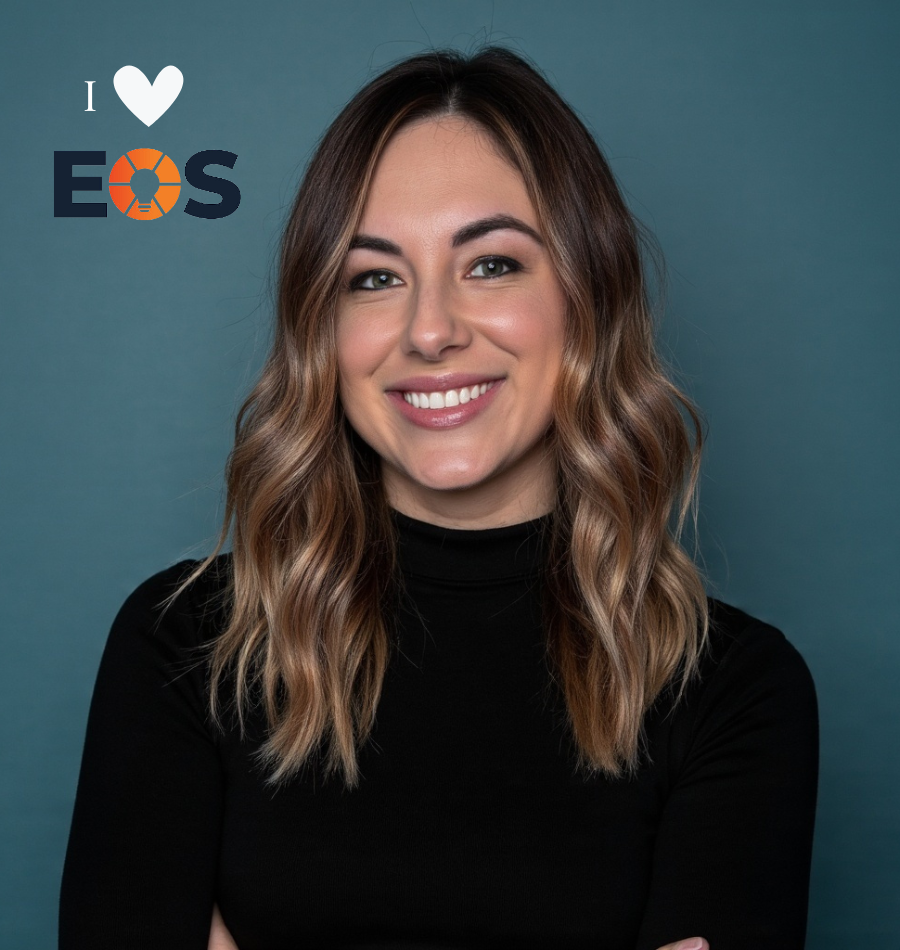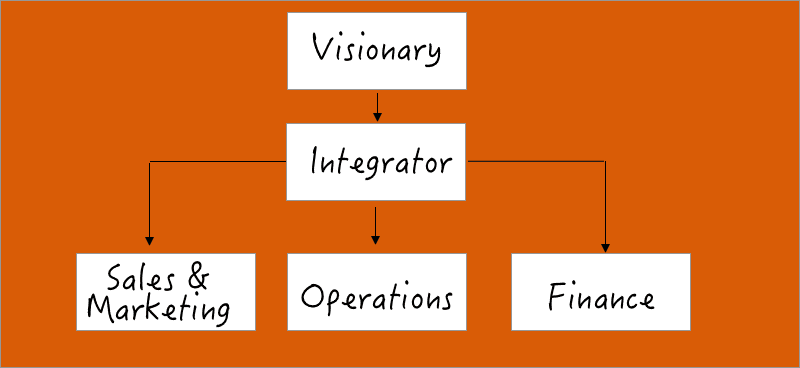Table of Contents
What is EOS?
EOS (Entrepreneurial Operating System) is a comprehensive set of simple, practical tools designed to help entrepreneurs and their leadership teams get what they want from their businesses. It’s a framework that helps businesses clarify their vision, set clear goals, and align their teams to achieve those goals.
EOS is structured around six key components that are essential for a business’s success:
- Vision: Clarifying the company’s vision, where it’s going, and how it plans to get there. This includes having a clear understanding of the company’s core values, focus, and long-term goals.
- People: Ensuring the right people are in the right roles. EOS emphasizes the importance of having a strong team of individuals who fit the company’s culture and can contribute to achieving its vision.
- Data: Using metrics and data to track performance, make informed decisions, and identify problems early on. It’s about focusing on the key numbers that drive the business forward.
- Issues: Addressing and solving problems quickly and effectively. EOS helps businesses identify and solve issues in real time, rather than letting them fester and slow down progress.
- Process: Defining and documenting the company’s core processes to ensure efficiency and consistency in operations. Having well-established processes allows teams to work more effectively and helps the business scale.
- Traction: Bringing the company’s vision to life by setting clear, actionable goals and ensuring accountability. This involves focusing on executing the company’s plans and creating discipline to meet deadlines and milestones.
By implementing EOS, businesses can create clarity, improve communication, and achieve greater alignment, leading to better results and a more efficient, productive work environment. It’s a powerful tool for entrepreneurs who want to transform their vision into reality and lead their teams to success.
Where we were before EOS
I won’t pretend that we had everything figured out before implementing EOS, nor will I claim that we have it all figured out now. What I will say is that in both cases, I’ve been fully committed to finding the most efficient way to run my business. Along the way, I’ve made plenty of mistakes and learned invaluable lessons.
Before EOS, we had systems and processes in place, scheduled meetings, job descriptions, a company handbook, training programs—you name it. We had been running a business for years, and we were clearly doing something right. I was generating leads, and we had a lot of people interested in working with us. Along the way, I lost several employees, whether due to resignations or the tough decisions I had to make. There were many wins and plenty of challenges. Ultimately, I was proud of what we had accomplished in such a short time, especially without any formal guidance.
So, if I’m being completely honest, before EOS, we were doing everything we knew how to do. But something still didn’t feel right. It was like we were spinning our wheels, not sure how to break through to the next level.
Introduction to EOS
One of my team members noticed the challenges I was facing while trying to navigate the growth of our company. She took it upon herself to learn more about the Property Management industry and started attending networking events. At a few of these events, she kept hearing about EOS, so she looked into it and immediately shared it with me.
I’m an open person and love when people bring me new ideas (though, if I’m being honest, that hadn’t happened much up to that point). Most of my team members at the time would simply ask me what needed to be done, without taking the initiative to research their roles or learn on their own. I couldn’t entirely blame them. I wasn’t always sure of the best approach myself, and many of my staff were young and inexperienced—not just in the industry, but in life as well.
So, when this particular team member brought me an idea, I was thrilled. I quickly googled EOS, and within minutes, I had purchased the book Traction. I was hooked. The whole concept resonated with me, and I was eager to dive in and learn more.
Preparing to Self-Implement
There are two ways to implement EOS in your business: you can hire an EOS Implementer, or you can choose to Self-Implement. EOS Implementers can be expensive, especially for a small business that wasn’t yet very profitable, so we decided to go the self-implementation route. Let me tell you, it was challenging. While the concepts are straightforward, figuring out how to apply them to our business was complicated because almost everything in our current operations had to change in some way.
I never want to introduce something new into my business without fully understanding it first. So, we started with the managers (now I know this as the Leadership Team) before we officially implemented it. I’m a diligent student, so I was eager to follow the book’s instructions. We read a section of the book, then worked through the exercises together. The first set of exercises came from the Vision Component, which was a great way to bring my managers together to completely reimagine the company’s vision. We worked through the entire book and gained a solid understanding of the system.
We began holding L-10 meetings with just our Leadership Team, although we had informed the staff that we were going to introduce something new. The timing couldn’t have been better. We planned our first Kick-Off meeting with the whole team to introduce them to EOS at the end of 2023. By the time we returned from the Christmas break, January of 2024, everyone would be ready to dive into EOS.
How my Staff Felt about EOS at First
I could sense that my staff was feeling nervous and uncertain about what was coming. They could see me and my Leadership Team spending days away from the office, which was a first. Naturally, that probably made everything feel a bit secretive and mysterious to them. I’m sure they were wondering what exactly we were working on and how it would impact them.
There were a few individuals, in particular, who I knew weren’t going to be fans of the changes. They were very comfortable with the way things were and didn’t want anything to disrupt that. I could almost feel their resistance, and I understood where they were coming from. Change can be unsettling, especially when things feel like they’re running smoothly.
However, overall, I believe the team trusted me. They knew that I wouldn’t do anything that would harm the business or make things harder for them. While they may have been unsure about the specifics, I think there was a general sense of confidence that I was guiding the company in a direction that would benefit everyone in the long run. Still, I knew that some anxiety was inevitable—whenever you introduce change, especially one as significant as EOS, there’s always a period of adjustment.
The Accountability Chart
The Accountability Chart has quickly become one of my greatest obsessions since we implemented EOS. Why? Because I’m deeply invested in my team, and I understand that getting the Right People in the Right Seats is the key to our success. The right structure is essential for growth, and the Accountability Chart is the tool that helps you make that happen.
I remember a few of my staff feeling uneasy when we introduced the Accountability Chart. For those unfamiliar, the Accountability Chart is like an Organizational Chart, but with a twist—it outlines the key functions that each seat in the company is responsible for, without being tied to any specific person. The idea is to structure your business in the best possible way first, then assign the right person to each seat. The goal is clear: put the Right People in the Right Seats.
The challenge for me came when I realized that we already had people in positions, and as we started mapping out the chart, it became clear that our existing structure wasn’t quite right. That’s when the reality set in—many of the roles we had were misaligned with the overall vision of the company. Suddenly, I was faced with a tough decision: how do you tell people that their current position might not be the right fit for them anymore? That they may be essentially “fired” from their role, only to be rehired into a new position, or perhaps not rehired at all? It felt nearly impossible, and the weight of that realization was overwhelming.
But I knew that in order for the business to thrive, we needed to make these tough decisions. The Accountability Chart, though challenging to implement, is the foundation of a well-structured, high-performing team. It’s not about replacing people—it’s about finding the right fit for everyone, including the company. And as much as it was a hard process, it was also a necessary one for growth and success.
One Year Into EOS: Our Journey So Far
After a year of operating with EOS, we’ve made tremendous progress, but we’re still far from fully integrating all its components. EOS is a system that pushes you to evolve constantly, and we’re embracing that challenge. Here’s a breakdown of how we implemented EOS, how it’s going, and the lessons we’ve learned along the way.
Vision Component
What It Is:
The Vision Component focuses on creating clarity around where your business is headed in 1, 3, and 10 years. This starts with the Vision/Traction Organizer (V/TO), which captures your Core Values, Niche, Proven Process, and long-term goals. It forces you to dream big and then reverse-engineer the steps needed to achieve those dreams.
When:
We began working on our Vision in Q4 2023 and introduced the V/TO at our 2024 Kickoff Meeting in December. Our team spent an entire day reviewing the company’s goals for the year, discussing the big picture, and closing the office to dive deep into alignment before heading into the new year.
How It’s Going:
We constantly revisit the V/TO each quarter to refine and update it. It’s a living, breathing document designed to evolve as the company grows. While we’ve made progress, I’d say there are still areas needing adjustment. That’s part of the beauty of the tool—it provides alignment while remaining flexible as we adapt to new realities.
Lesson Learned:
If I could do it over again, I’d have tackled this component later. Without understanding how all the EOS components fit together, the Vision was hard to solidify initially. Since then, we’ve revised our V/TO several times, which is completely normal, but I wish we had started with a stronger grasp of the system as a whole.
People Component
What It Is:
This component is all about getting the Right People in the Right Seats using tools like the Accountability Chart and People Analyzer. It ensures that every person’s role aligns with their strengths and contributes to the company’s goals.
When:
We began addressing the People Component in Q4 2023, introducing it at our 2024 Kickoff Meeting. We assigned roles using the Accountability Chart and had staff participate in a People Analyzer exercise to evaluate their fit within their seats.
How It’s Going:
This has been one of the most transformative parts of EOS for us. The Accountability Chart became a game-changer, giving us clarity about roles and responsibilities and helping us create job descriptions that align with company needs. It has required constant updates as we grow, but my team’s willingness to adapt has been inspiring.
Lesson Learned:
One of the toughest decisions I faced was letting go of my sister because she wasn’t the right fit for the company. While painful, it was a turning point. Keeping someone who isn’t the right fit—even a loved one—can hold the business back. The positive shift in morale afterward was undeniable and reinforced my commitment to the EOS framework.
Issues Component
What It Is:
The Issues Component teaches you how to solve problems permanently using the IDS (Identify, Discuss, Solve) method. The goal is to address root causes so issues don’t resurface.
When:
We introduced this concept during the 2024 Kickoff Meeting and fully integrated it into our Level 10 (L10) Meetings by Q1 2024.
How It’s Going:
We’ve gotten better at using IDS to uncover root issues, though it’s still a work in progress. One key improvement has been encouraging staff to add their issues to the list for discussion during meetings. This ensures we prioritize and address the most pressing concerns.
Lesson Learned:
Not every issue is truly an “issue.” Some are simply to-dos or minor adjustments. Learning to differentiate has been a big part of our growth.
Data Component
What It Is:
This component is about tracking the right numbers through a Scorecard, which provides weekly insights into your business’s performance. It’s a forward-looking tool, unlike a P&L, which reflects past performance.
When:
We started with the Leadership Team in Q2 2024, then rolled it out company-wide in Q4 2024.
How It’s Going:
Creating a Scorecard that accurately reflects our business has been a challenge. It’s taken multiple iterations to identify the right metrics to track, but we’re improving each quarter.
Lesson Learned:
Don’t get discouraged if you don’t get it right the first time. It’s a learning process, and adjusting your Scorecard is part of the journey.
Traction Component
What It Is:
This component introduces Rocks (90-day priorities) and the Meeting Pulse (a system of weekly, quarterly, and annual meetings) to keep everyone aligned and moving forward.
When:
We implemented the weekly meetings in Q1 2024 and introduced Rocks in Q4 2024.
How It’s Going:
Our meetings have become a cornerstone of our operations. While there’s still room for improvement in areas like IDS, the structure keeps us focused and productive.
Lesson Learned:
Having the right facilitator and scribe is crucial for effective meetings. These roles ensure discussions stay on track and issues are resolved efficiently.
Process Component
What It Is:
This component involves documenting your core processes and assigning ownership to specific roles within the Accountability Chart.
When:
We haven’t formally implemented this yet, though we have SOPs and a Process Management System in place.
How It’s Going:
This is an area we plan to focus on soon, as it will help us streamline operations and ensure consistency.
Lesson Learned:
In hindsight, we should have introduced this alongside the People Component. Documenting processes earlier would have made subsequent components, like Data, much easier to implement.
Final Thoughts
One year into EOS, we’ve seen incredible growth—not just in our business but also in how we operate as a team. While there’s still a lot to learn and improve, the tools have provided us with clarity, direction, and alignment. Change is never easy, but it’s always worth it when it helps you build a stronger, more resilient company.







0 Comments